One of the trickiest parts of a chess game for players of all different levels is that moment right when the opening ends. You’ve castled your king, developed your pieces and now you have to answer the question, “What do I do now?”
In this article, I have compiled a list of the top 10 best chess middlegame strategies that you can implement in your games right after the opening.
The middlegame is the part of the chess game where most of the action takes place. Without a clear middlegame strategy, you will easily make a lot of blunders as you won’t know what to do.
There is a lot of strategic ideas in the middlegame, but choosing the right one will depend on the nature of the position.
Here are the 10 best chess middlegame strategies to use in your games:
- Break Open In The Center
- Attack Your Opponent’s King With A Pawn Storm
- Trade A Weak Piece
- Create A Battery On An Open or Half-Open File
- Create A Diagonal Battery
- Create A Rook Lift
- Relocate Your Knight To An Outpost
- Attack Weak Pawns
- Elimintate Your Weakness Before Your Opponent Attacks It
- Decrease The Activity Of Your Opponent’s Pieces
Best Middlegame Strategy
1. Break Open In The Center
If there is one part of the chess board you need to play, then that part is the center. Playing in the center of the board is a much more effective middlegame strategy than playing on the flanks.
The center of the board is where are all your forces are concentrated, so it makes sense why you should play there.
One of the best times to break open the center is when all your pieces have been developed and your opponent has not yet castled his king.
In the position below, it is white to move. White has all his pieces developed but Black’s king is still not yet castled. White has the opportunity to break open the center with the move pawn to e5 which takes advantage of the fact that black’s king is uncastled.

If black captures the pawn, the white knight will recapture, and suddenly white has an open d-file and a half open e-file for his rooks to come into the game.

Black has to be very careful as if he tries to make a natural looking move such as castle, white can win a piece after the exchanges on d7.

2. Attack Your Opponent’s King With A Pawn Storm
A pawn storm is a common middlegame strategy where you advance your pawns on either flanks in order to open lines and attack the king. This strategy is common in openings like the Yugoslav attack in the Sicilian Defense where both players castle on opposite sides of the board.
Pawn storms are usually prepared by castling queenside and then launching your kingside pawns up the board.
In the position below, white’s strategy is to create a pawn storm with the moves g4 and h4.

White’s idea is:
- To play h5 and open up the file for his rook.
- Play bishop to h6 to trade off Black’s fianchettoed bishop that is protecting the dark squares around the king.
- Then white will use his queen and rook to mate black along the h-file.
When preparing a pawn storm, it’s a good idea to move your king over to the b1 square. This gets the king off the c1-h6 diagonal as black can potentially deliver some unwanted checks with his bishop. By makng this prophylaxis move, you won’t have to be constantly calculating annoying checks along the diagonal.
3. Trade A Weak Piece
One of the most effective middlegame strategy is to trade one of your weak pieces for one of your opponent’s stronger pieces.
For example, if your opponent has an active bishop that is fianchettoed along an open diagonal but your bishop is stuck behind your own pawns, then it’s a good idea to trade off your bishop for his fianchettoed bishop.
In the position below, white’s bishop on b2 is very strong as it controls the central squares and is putting pressure on black’s kingside.

On the other hand, black’s bishop on e7 is less active. If we could get it to challenge white’s bishop on b2, then we could equalize the imbalance.
If we ask ourselves that question, then we immediately see the strategy of placing it on the f6 square. We can do this by moving the knight on f6 to d7, so that the bishop can go there.
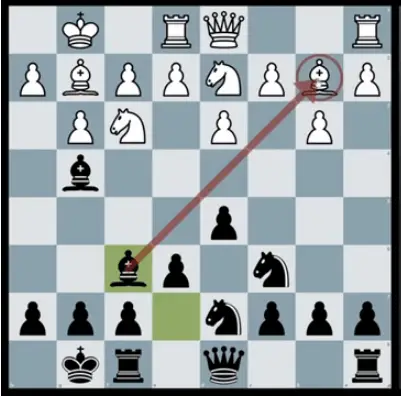
After bxf6 Qxf6, Black has successfully gotten rid of his weak bishop for his opponent’s active bishop. Black has significantly improved his position by making that simple manouevre of trading off the bishop.
4. Create A Battery On An Open or Half-Open File
A battery in chess is when you line up long ranged pieces along the same file or diagonal. A bishop and a queen along the same diagonal is one example of a battery. A rook and a queen along an open file is another example of a battery.
In the following position, white managed to create a battery along the open e-file using his 2 rooks and queen. This adds significant pressure to black’s pieces, particularly the e7 bishop, and sets up a lot of tactics because of the battery.

5. Create A Diagonal Battery
The position below shows another type of battery involving the queen and bishop along b1-h7 diagonal.

White is adding pressure to the h7 pawn because of the battery, and is threatening to win the pawn after Bxf6 which removes its defender.
However, an even better battery is to put your queen in front of the bishop. This not only threatens to win a pawn on h7, but it threatens to checkmate the king after Bxf6.
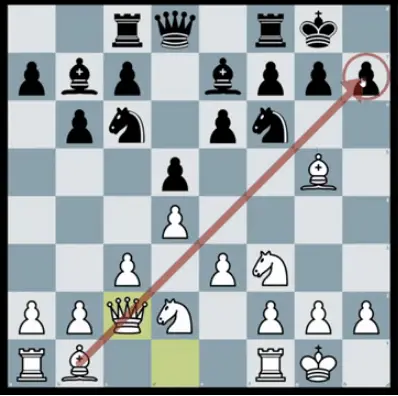
To achieve this kind of setup, white calmly drops his bishop back to b1 from d3, then the queen goes in front of it.
6. Create A Rook Lift
Attack your opponent’s king by using what is a called a “rook lift”. Rooks are often not seen until the end of the game as they are stuck in the corner and behind pawns. However, this can change by creating a rook lift, usually on the 3rd rank for white, or the 6th rank for black, then bringing it over to the kingside where it will remain unbothered.
This strategy is more successful when the center is closed.
When creating rook lifts, you have to clearly map out the path to which the rook will move. Look for any pieces that could potentially attack or trap your rook if it gets to the kingside. If there are pieces that can harass or attack your rook, then it’s probably not a good idea to lift it over to the kingside.
In the position below, white does a rook lift by first advancing the pawn to f4 to create the path for the rook to go on h3. From h3, the rook will add pressure to the h7 pawn. White’s attack will be powerful.

7. Relocate Your Knight To An Outpost
An outpost is a square that is supported by your pawn and cannot be attacked by your opponent’s pawn. This is usually the square on the fourth, fifth, sixth, or seventh rank.
The less minor piece that can attack the square is the stronger the outpost. For example, in the position below, the white knight on c6 cannot be harrassed by another piece less or equal to its value.

In other words, if the knight should be removed, black would have to give up the exchange using his rook which is worth more than a knight. However, in this case, the knight is the one that is more powerful than the rook.
So how do you get your knight to an outpost?
Well, the simple thing to do is to map out a clear path for the knight. Take some time to look at the route the knight will go.
In the position below, white will love to stick his c3 knight on the e5 square. However, black will just simply trade it off with his e7 knight.
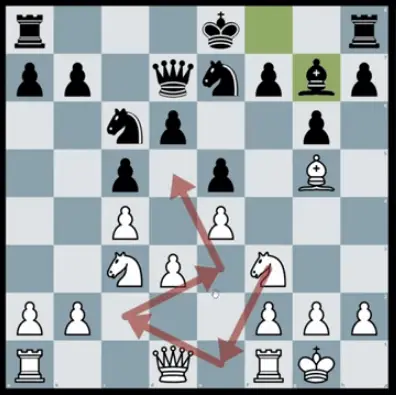
A more effective approach is to get your f3 knight to e5, so that the c3 knight can recapture it if the black knight captures on e5.
To get there, white would have to move his f3 knight via e1-c2-e3-d5
8. Attack Weak Pawns
Weak pawns can be categorized into the 3 groups:
- Backward pawn
- isolated pawn
- double pawn
In the middlegame you should always look for ways to create weak pawns in your opponent’s position, and then use your pieces to attack them.
Weak pawns such as doubled and isolated pawns are long term weaknesses and can be exploited in the endgame when most of the pieces are traded off.
Backward pawns should be attacked in the middlegame when you have most of your major pieces on the board such as your rook and queen.
In the position below, black has a terrible pawn structure. He has doubled pawns on the b and h-file. There is also a backward pawn on the e-file that white can immediately start targeting with his heavy pieces.
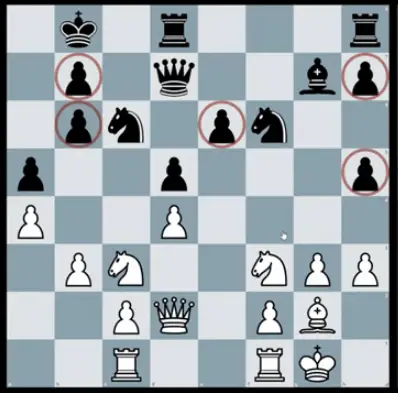
White can pile up his heavy pieces along the e-file to create a battery against the backward pawn.
Another clear target for white is black’s h5 pawn. White can attack this by playing Nh4, Bf3, Qd1.
All in all, the goal is to figure out where the weakness is in your opponent’s position and then try to attack it.
9. Elimintate Your Weakness Before Your Opponent Attacks It
The strategy of eliminating your weakness before your opponent attacks it is an advanced strategy performed by many top level players.
One common line is in the Sicilian defense. In the position below, white’s bishop on c4 can be attacked if black plays b5 or Qc7.
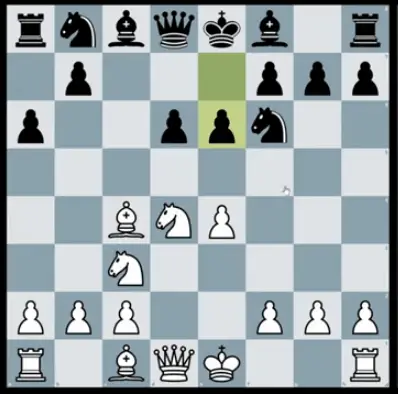
The main move for white to play in this position is actually Bishop to b3. When you first look at that move, you might think “Why are you moving the bishop when nothing is attacking it?”
However, the reason you would make a move like this is that you are anticipating that it could come under attack in the future, but you decide to deal with that problem right away.
For example, if you leave the bishop on c4, black would have all sorts of nasty ideas such as Nxe4 and d5 (forking the bishop and knight)

By playing Bishop to b3, you no longer have to worry about this.
10. Decrease The Activity Of Your Opponent’s Pieces
The last and final middlegame strategy is to choose one of your opponent’s pieces and try to make it as ineffective as possible.
While it’s good to try and activate your own pieces, many players forget that they can decrease the activity of their opponent’s pieces instead. Let’s look at an example.
In the position below, black gave up his dark squared bishop for white’s knight on c3.

A common strategy moving forward is to deploy your pieces on dark squares, thereby making your opponent dark squared bishop ineffective and passive.
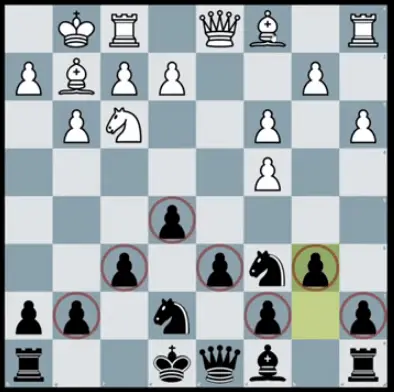
As you can see, white successfully managed to carry out that plan. Almost all his pawns are on dark squares, making white’s dark squared bishop look rather stupid.
Final Verdict
So there you have it, “The 10 best chess middlegame strategies”. Not all of them will work in every game, but if you keep them at the back of your mind, you should have some good ideas to hopefully help you in your next games.
Related Post: 10 Effective Chess Strategies To Win


